Many Rolex watches have earned nicknames that – while entirely unofficial – are now commonplace among Rolex collector terminology. Other than the names of the different watch lines, the only official “names” that Rolex gives their timepieces are the reference numbers that correspond to a particular watch’s model, configuration, and materials.
Here Is The List
With that in mind, some of the nicknames that various Rolex watches have acquired over the years have become so commonly-used and widely-accepted that they are about as “official” as a name can be without Rolex explicitly printing them in their catalogs.
Below is a brief overview of some of the most common Rolex nicknames and the different watches that have earned them. By no means is this list exhaustive; however the nicknames on this list are so commonly used, that you will most certainly come across them if you have not already.
Pepsi
While the red and blue bezel insert of the first GMT-Master was originally produced in its now-iconic color scheme to match Pan-Am Airlines’ company colors, a Rolex GMT-Master with red and blue bezel insert is frequently referred to as a “Pepsi” GMT due to the insert’s resemblance to the famous soda company’s logo.
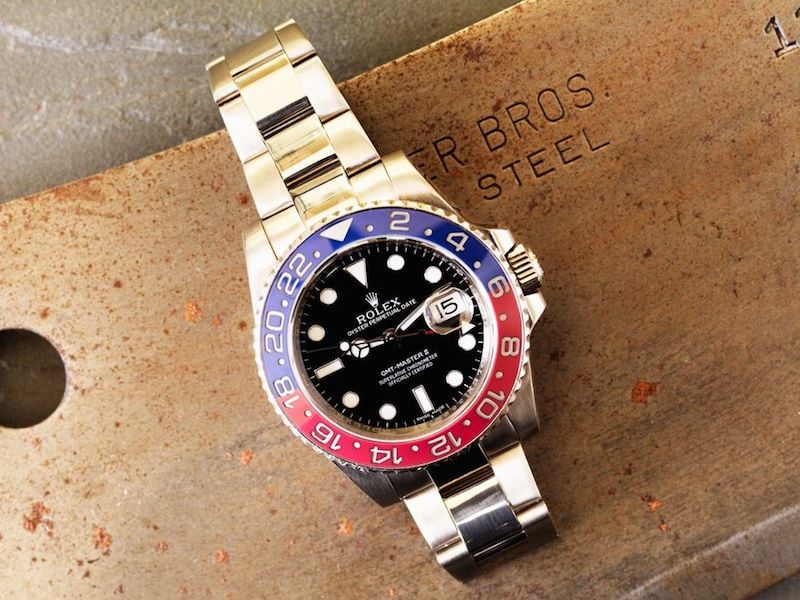
A White Gold GMT-Master ref. 116719BLRO.
Any Rolex GMT-Master or GMT-Master II can be called a Pepsi GMT, as the name really only refers to the watch’s bezel insert; however as the only Rolex currently in production with a red and blue bezel insert is the solid white gold GMT-Master II, the Pepsi nickname is most frequently used in conjunction with vintage watches.
Coke / Coca-Cola
In the same way that Rolex GMT-Master and GMT-Master II watches with red and blue bezel inserts get called Pepsi GMTs, those with red and black inserts have acquired a nickname that corresponds to the other leading cola manufacturer.
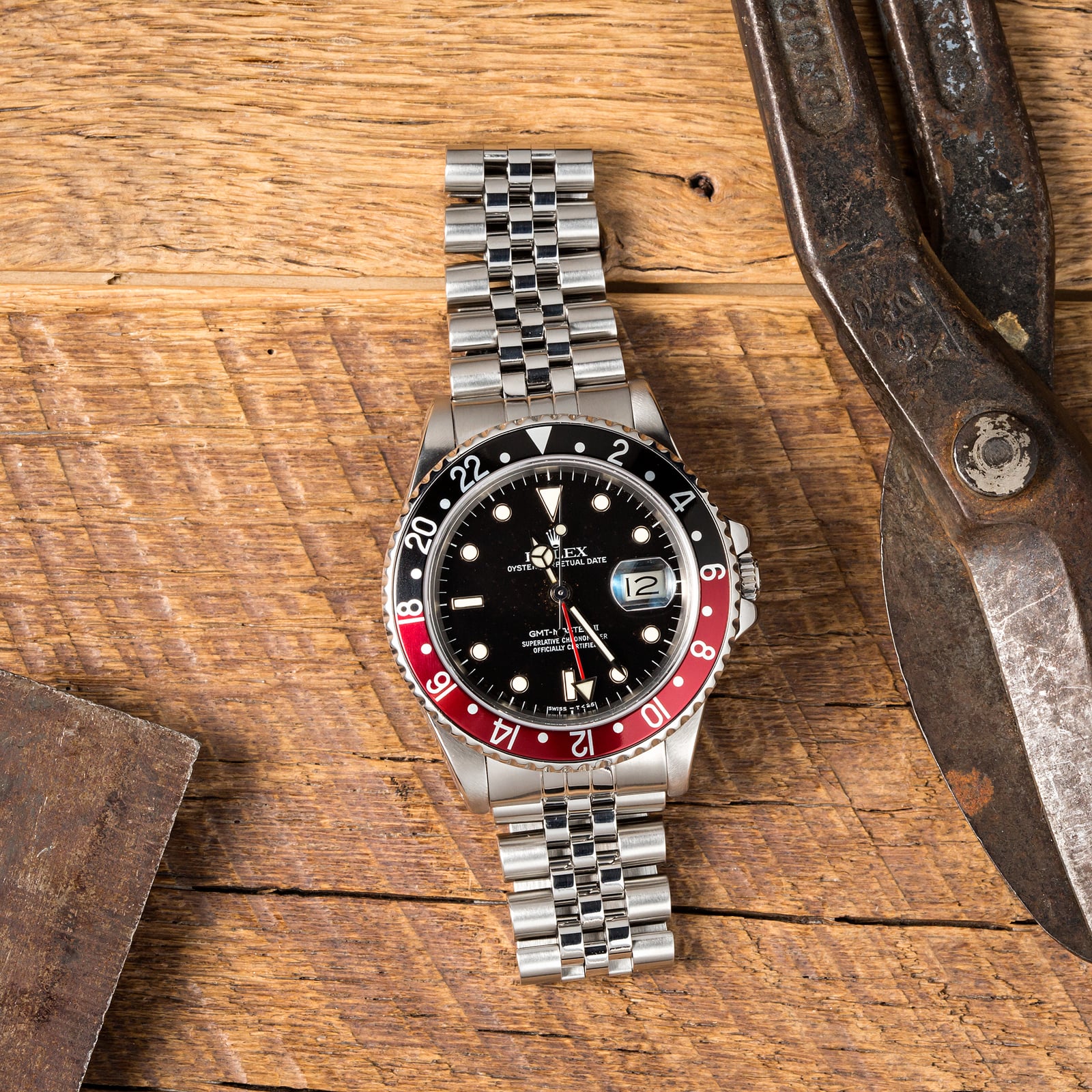
The Black and Red Bezel got this GMT its nickname: Coke.
Although the Coca-Cola Company’s colors are actually red and white, the overall color profile of a stainless steel GMT with its black dial and red and black bezel insert, is not all that dissimilar to a full bottle of Coca-Cola, with its bright red and white label contrasting against the dark-colored fluid inside.
Root Beer
Keeping with the soda theme and Rolex’s GMT line of watches, those with brown dials and inserts have earned the nickname “Root Beer” GMTs. The brown dial and bezel insert configuration most frequently appears on Rolesor(two-tone) versions of Rolex’s GMT; however some all-gold renditions can be found with brown dials and bezel inserts.
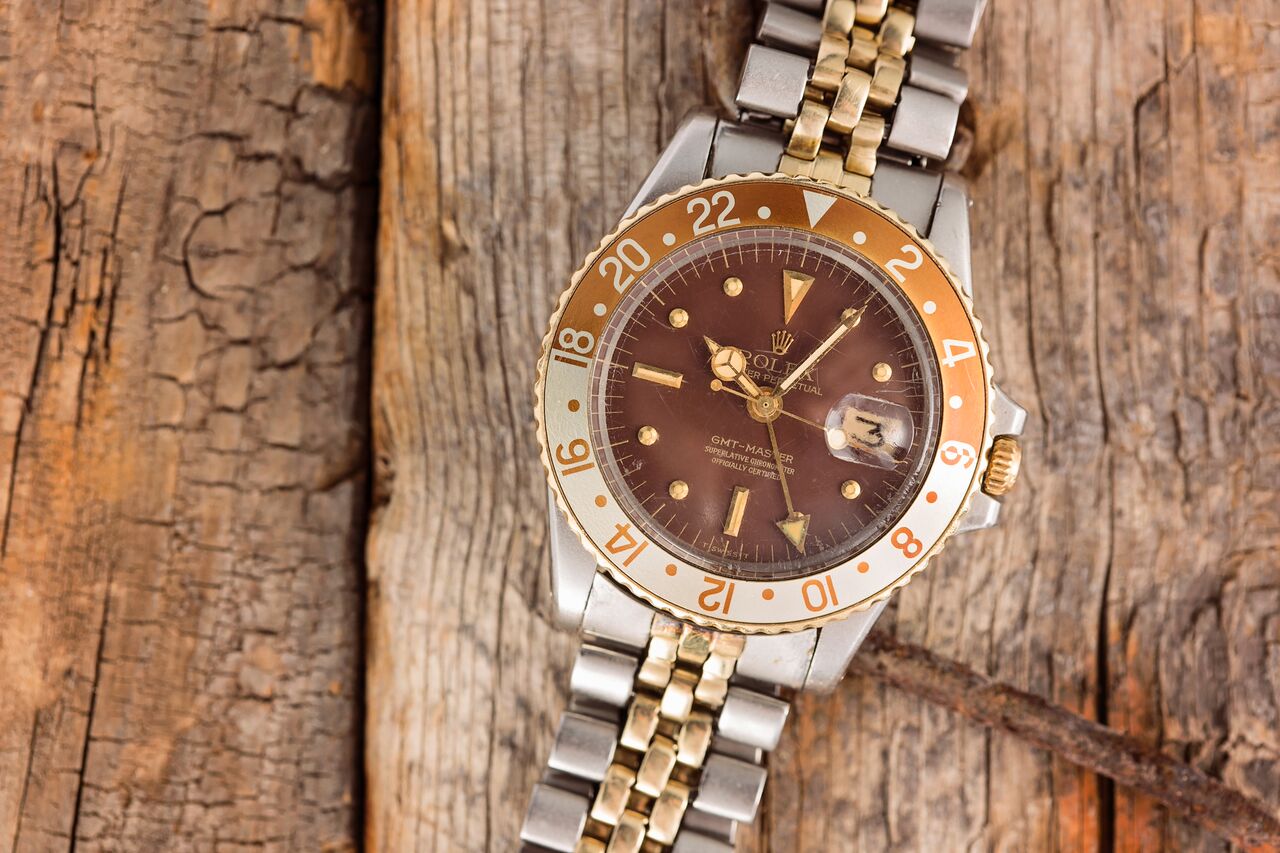
Somehow people kept to the theme of sodas. This is the Root Beer.
The brown and gold color profile of Root Beer GMTs is vaguely reminiscent of a frothy glass of root beer; however, it is likely that the “Root Beer” nickname was primarily a result of two other GMT-Master watches having soda-related names. Regardless, the “Root Beer” nickname has stuck, and it has become a mainstay in the world of Rolex collecting.
Hulk
The green Rolex Submariner with Green Cerachrom (ceramic) bezel insert (reference 116610LV) has earned the nickname the “Hulk” due to its all-green color profile and thick case design. Although it is not the first time that Rolex has used the color green on the Submariner line of watches, the “Hulk” (released in 2010) marks the first time that both the dial and bezel insert have been manufactured in any color other than black or blue.
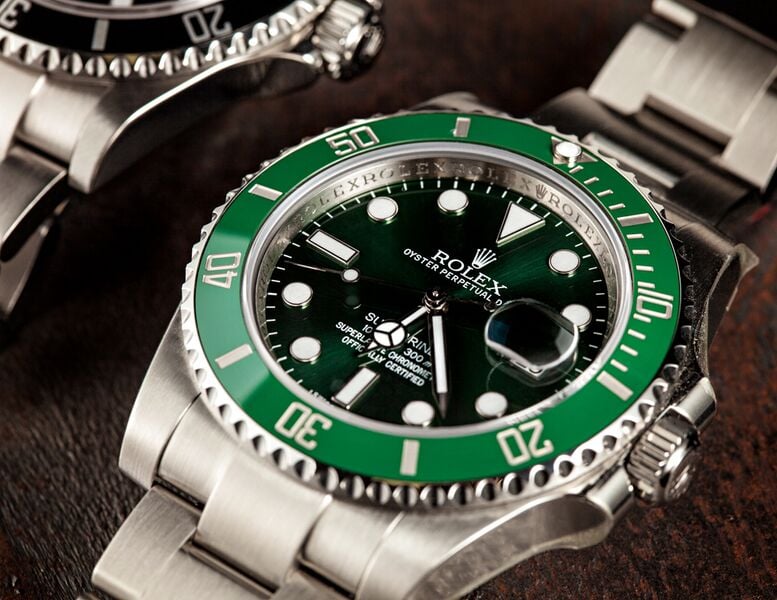
All Green Rolex Submariner 116610LV. Need I say more?
While a purple strap would be required in order to fully embrace the “Hulk” nickname, the thick construction of the redesigned Submariner case, combined with the all-green color profile of the reference 116610LV, makes for an overall appearance that is understandably reminiscent of Marvel Comics’ famous, green superhero.
Batman
While the all-green Submariner has earned the nickname the “Hulk”, another one of Rolex’s contemporary sport watches has also found itself with a superhero nickname. GMT-Master II watches that have been fitted with black and blue Cerachrom bezel inserts and blue 24-hour hands are frequently called “Batman” GMTs due to their dark color profile that embraces similar hues to Gotham’s superhero from the old DC comic books.
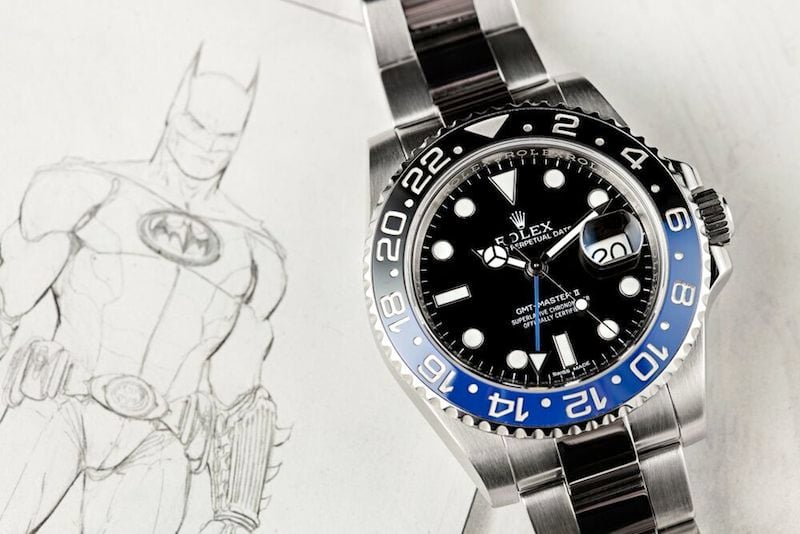
A Rolex GMT-Master II called “Batman” for its black and blue bezel.
President
Many people know Rolex’s Day-Date line of watches simply as the Rolex “President.” While the “President” name actually only applies to a specific style of bracelet, it has become possibly the most commonly used nickname in the world of Rolex ownership.
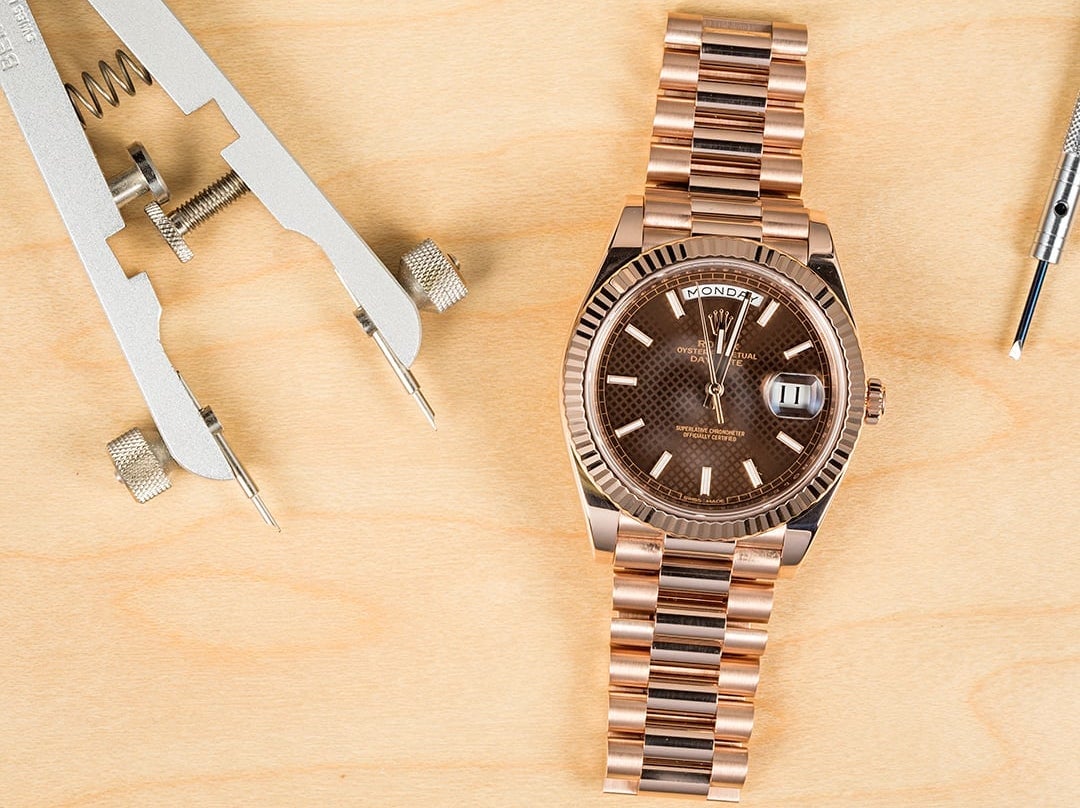
A Rolex Day-Date President ref. 228235 mainly because many Presidents have been seen with one.
The President bracelet was designed specifically for Rolex’s Day-Date line of watches, and it is only constructed from solid platinum or 18-karat gold. The President nickname is the result of a long history of Day-Date ownership by a number of different United States Presidents, and over the years, the President name has become synonymous with Rolex’s Day-Date line of watches.
Paul Newman
One of the Holy Grails of Rolex collecting is a Paul Newman Daytona. The only thing that separates a “Paul Newman” from an ordinary vintage Rolex Daytona is the dial, which slightly differs in font, colors, and configuration. Although subtle, the differences give it a more exotic, somewhat retro appearance.
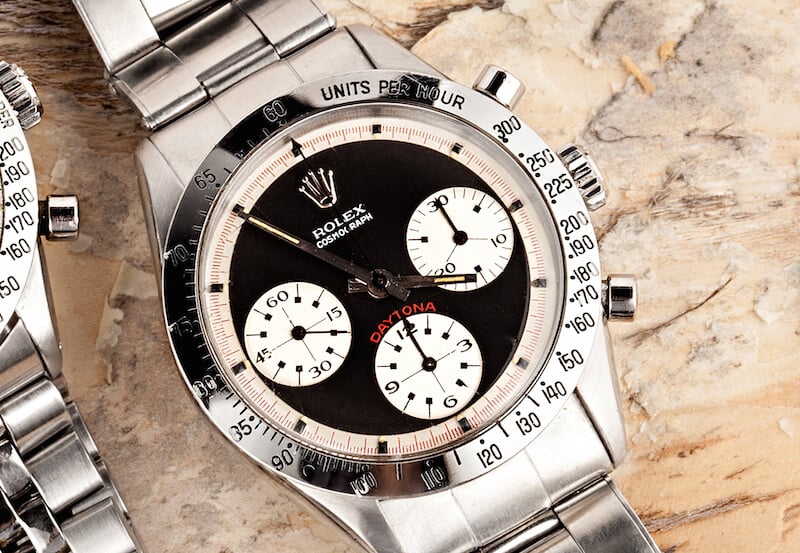
A Paul Newman is a collectable watch. Called Paul Newman since the actor Paul Newman worn it on a daily basis.
Originally, Rolex had trouble selling these slightly unconventional Daytona dials, and most customers of the time preferred their watches to have a more traditional appearance. Due to their lack-luster sales, Rolex produced a relatively small number of these exotic dials, making them quite rare and valuable among collectors today.
According to legend, Paul Newman wore one of these Rolex Daytona watchs during a photo shoot for an Italian magazine, and due to Newman’s star-power and a strong Italian collector/dealer network, these funky-dialed Daytona chronographs – that saw such poor sales numbers during the 1960s and 1970s –became a huge phenomenon in the world of watch collecting during subsequent decades.
James Cameron
As a tribute to filmmaker James Cameron’s successful 2012 descent to the deepest part of our planet’s ocean, the Mariana Trench, Rolex released a special edition of its Sea-Dweller line of watches, the Rolex Deepsea Sea-Dweller with D-Blue Dial.
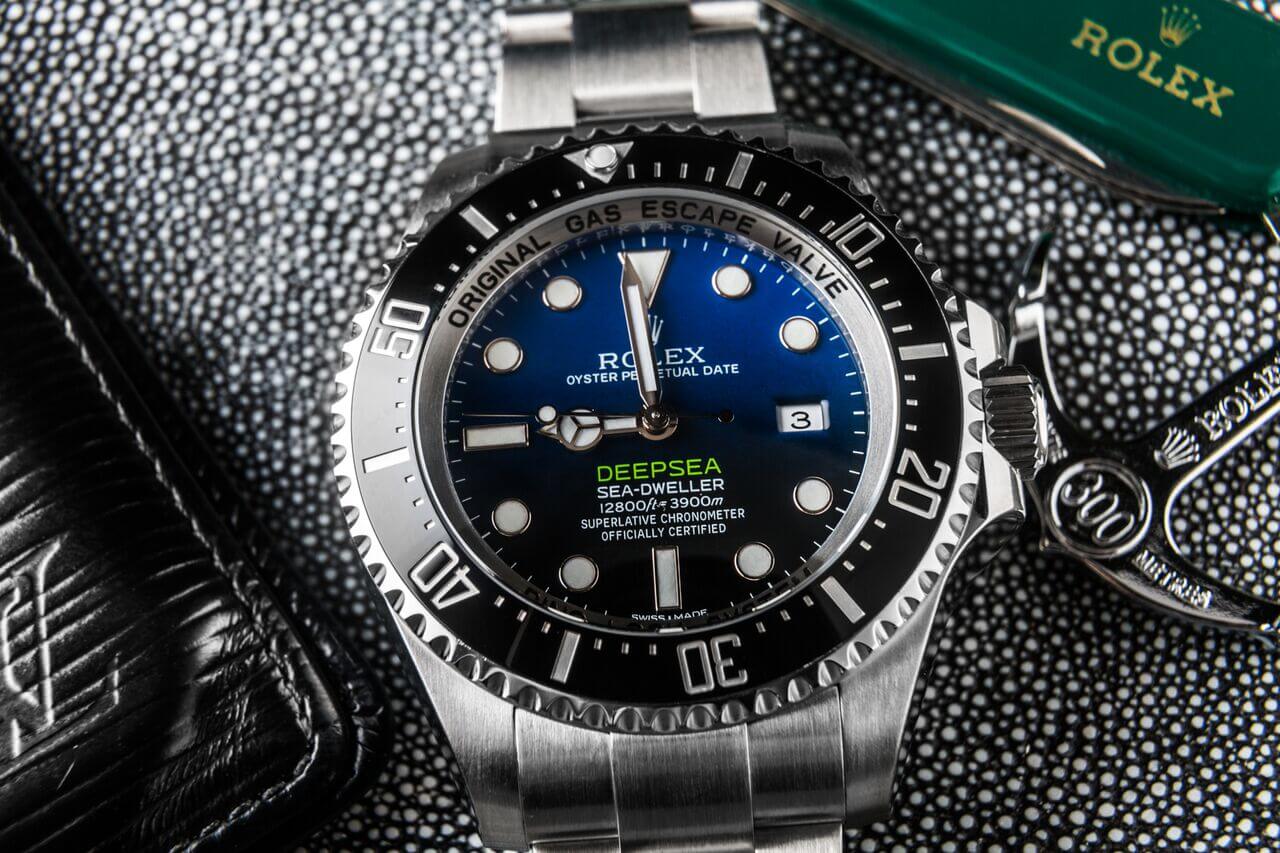
Rolex Deepsea D Blue Dial ref. 116660
Rolex supplied Cameron’s mission with a specially designed timepiece that was built to withstand the massive pressures present at the bottom of the ocean; and to celebrate their achievement (and Cameron’s), they released a special edition of their Deepsea Sea-Dweller watch, which has since earned the nickname, the “James Cameron.”
The only difference between the “James Cameron” and the regular Deepsea is the dial of the watch, which fades from deep blue to black, and has the Deepsea name printed in bright green letters.
Steve McQueen / Freccione
As the original Rolex Explorer II, the reference 1655 has acquired a variety of different nicknames over the years, including “Il Freccione” and the “Steve McQueen.”
“Il Freccione” roughly translates to “the arrow” in Italian, which is an obvious reference to the first Explorer II’s most noteworthy feature: its large, bright orange, 24-hour hand.
As for the “Steve McQueen” nickname, its origins trace back to a Rolex advertising campaign from the 1970s, in which the watch manufacturer had used McQueen’s image to try to boost sales of the slightly obscure watch designed for speleologists.
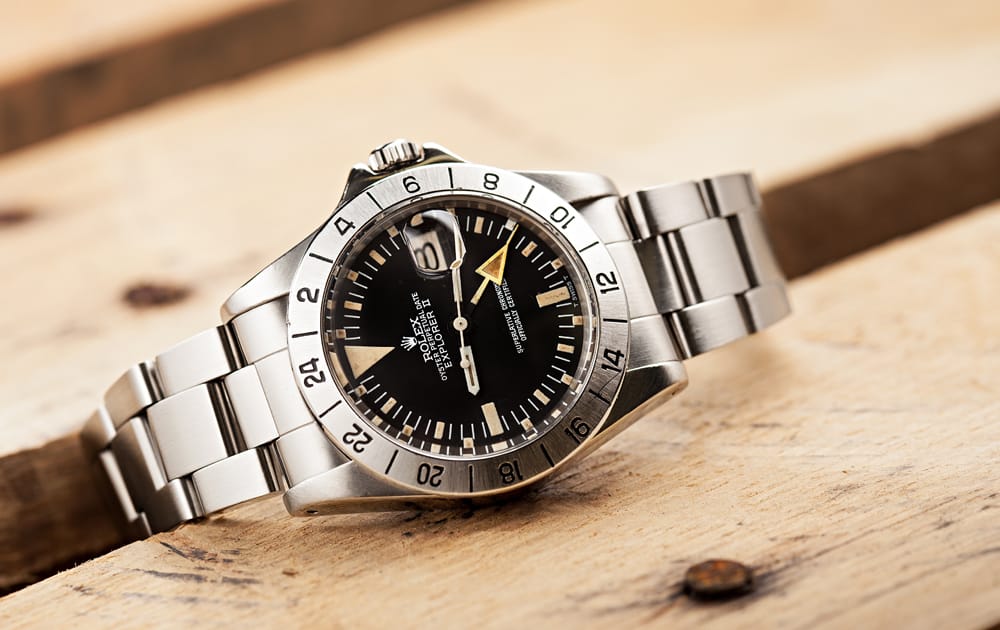
The Rolex Explorer 1655 has the nickname “Freccione”.
Despite sharing his name, the reference 1655 was never actually worn by Steve McQueen. In his personal life, McQueen chose to wear a stainless steel Submariner; however the high-profile advertisement campaign made such an impression that the reference 1655 Explorer II will forever be known as the “Steve McQueen.”
Thunderbird
The “Thunderbird” nickname applies to any Rolex Datejust watch that is fitted with a rotating bezel (also known as a Turn-O-Graph). During the late 1950s, the U.S. Air Force Thunderbird squadron frequently used Rolex watches with rotating bezels. Rolex took full advantage of this marketing opportunity and released a special series of Datejust watches fitted with rotating bezels and the Thunderbird’s logo printed on the dial.

A Rolex Turn-O-Graph “Thunderbird” ref. 116261. Used by the military, the Thunderbirds utilized a DateJust.
Today, a Datejust with a rotating bezel is branded as a Turn-O-Graph; however the Thunderbird nickname lives on, and all rotating-bezel Datejust watches are affectionately called “Thunderbirds” by many members of the Rolex collecting community.
Kermit

The Kermit has a black face with a green dial.
While the green Rolex Submariner with green ceramic bezel insert has earned the nickname the “Hulk”, Rolex’s 50th anniversary edition Submariner has been nicknamed, “Kermit” by members of the Rolex-owning community.
Released in 2004 to celebrate the 50th anniversary of the iconic Submariner line, the reference 16610LV marks the introduction of Rolex’s Maxi dial, which features larger hour markers than its predecessors. The reference 16610LV gets its “Kermit” nickname from its black and white Maxi dial and green aluminum bezel insert, which give it an appearance that is somewhat reminiscent of Sesame Street’s famous frog character.
Smurf
Rolex’s reference 116619 Submariner is craft from solid 18-karat white gold, and features a blue Cerachrom (ceramic) bezel insert and dial. Although it represents Rolex’s premium offering in the Submariner line of watches, the reference 116619 has been nicknamed the “Smurf” due to its all blue and white color profile, and the bright, flat hue of its dial and bezel insert.
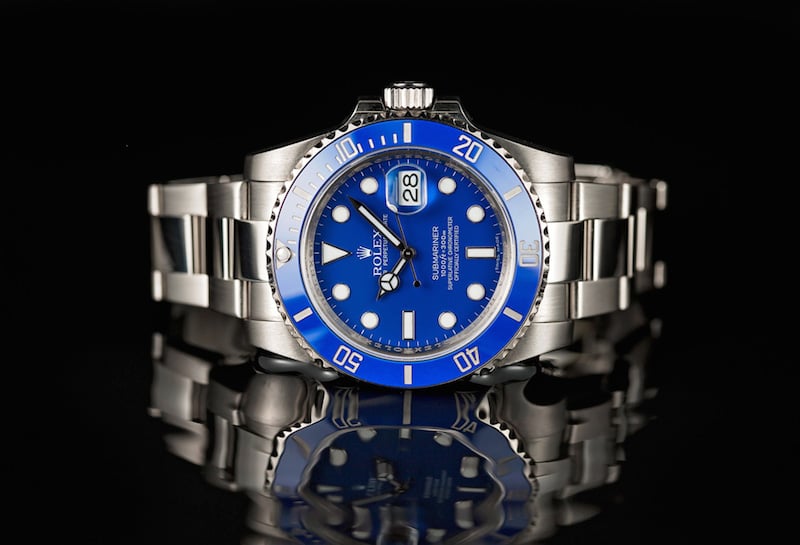
This Rolex Submariner ref. 116619 comes with a blue and white face earning the name “Smurf”.
The “Smurf” Submariner has become a favorite among celebrities and professional athletes due to its combination of premium materials and an understated, yet elegant appearance. Although it has a cartoon nickname, the “Smurf” Submariner costs more than any other contemporary Submariner reference and truly represents the apex of luxury and function.
Padellone
For many vintage enthusiasts, the reference 8171 triple calendar moonphase represents one of the Holy Grails of Rolex collecting. At 38 mm in diameter, the reference 8171 is a rather large watch by Rolex standards – especially considering that it was first introduced to the public in 1949, when wristwatches were small, and the average size of a men’s watch was in the low 30 mm range.
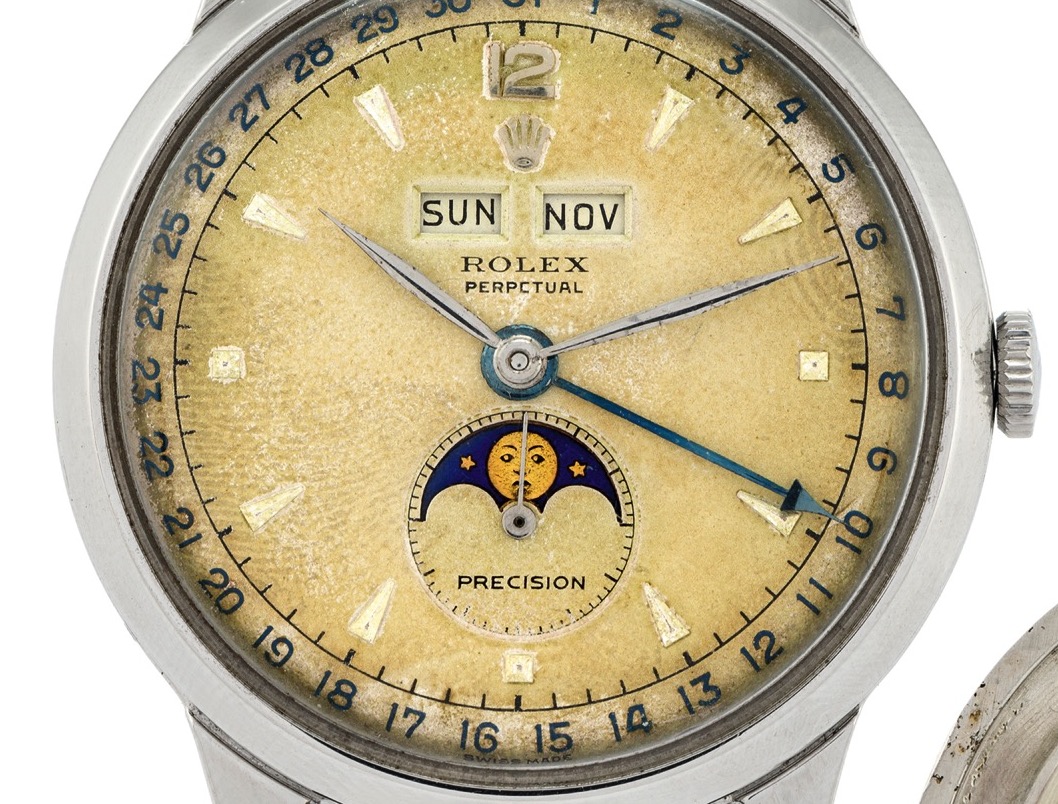
Rolex ref. 8171 “Padellone”
The name “Padellone” is Italian for a “large frying pan”, which is a reference to the watch’s sizeable diameter and sharp curved lugs that stick straight out from the sides of the watchcase. Many consider the “Padellone” to be one of the most well-proportioned Rolex references of all time, and its triple calendar function, plus moonphase complication makes it also one of the most feature-rich references that Rolex has ever produced.
Bubbleback
During the 1930s, Rolex began fitting their watches with automatic, self-winding movements. The addition of the oscillation weight to the movement increased its overall thickness, and required additional clearance for the rotor to move freely inside the case. Rather than making the entire case of the watch larger, Rolex decided to allow the caseback to protrude out further in a bubble-shaped fashion.
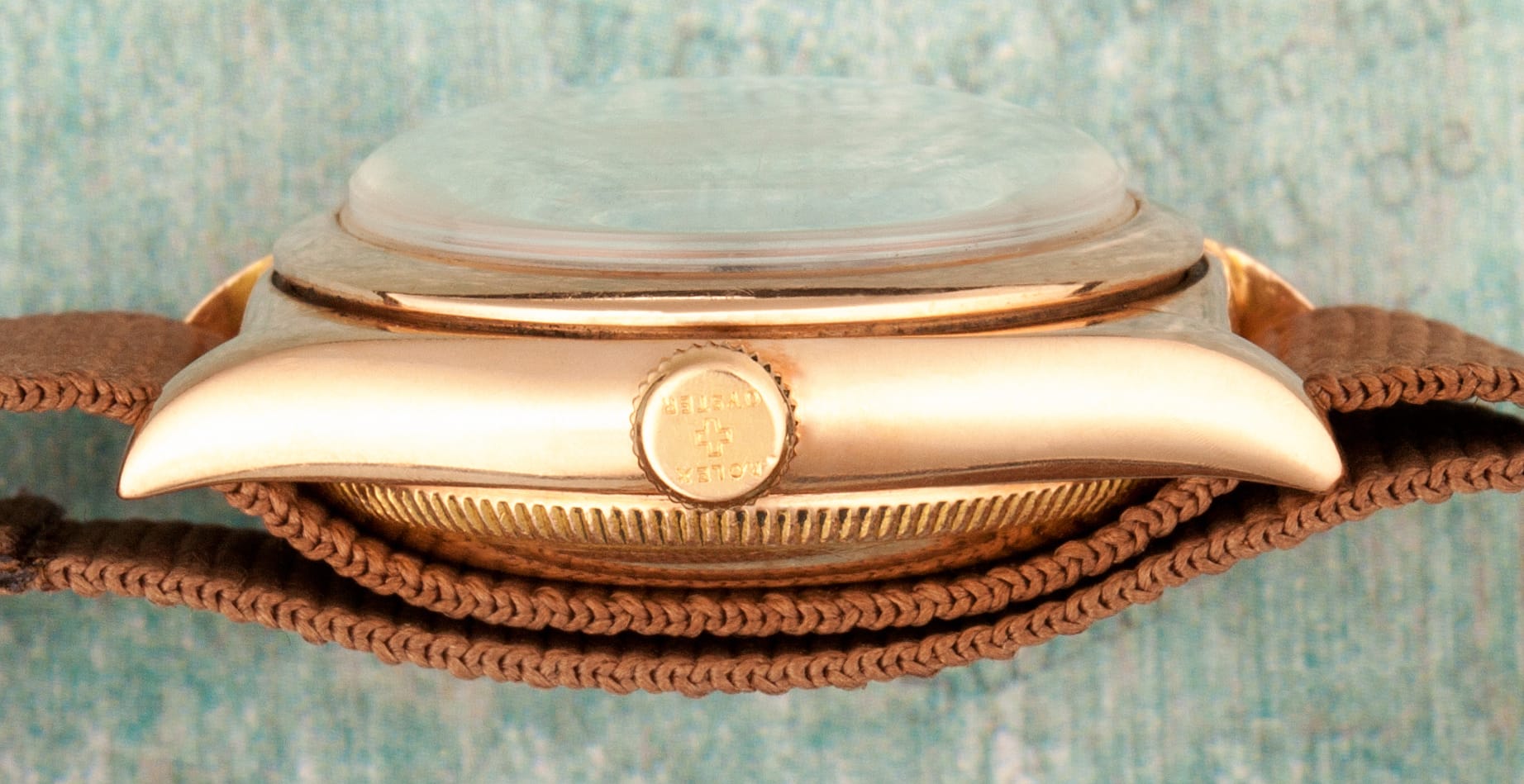
The Rolex Bubbleback 3131 earned its name for its round caseback.
Although their large, dome-shaped casebacks have earned these watches a variety of different nicknames throughout the years, the “Bubbleback” nickname is probably the most well known and commonly used among collectors and enthusiasts. The small diameter and relatively large overall thickness combine to make a somewhat awkward and strangely proportioned watch; however Bubblebacks represent an early point in Rolex’s history, when the company was first starting to refine the designs of their self-winding movements.
Fat Lady
In 1983, Rolex released the first GMT-Master II, the reference 16760. As an update to the GMT-Master line of watches, the reference 16760 marked the introduction of an independently adjustable 24-hour hand. Additionally, the watch was only available in stainless steel, and with the red and black, “Coke” bezel insert option.
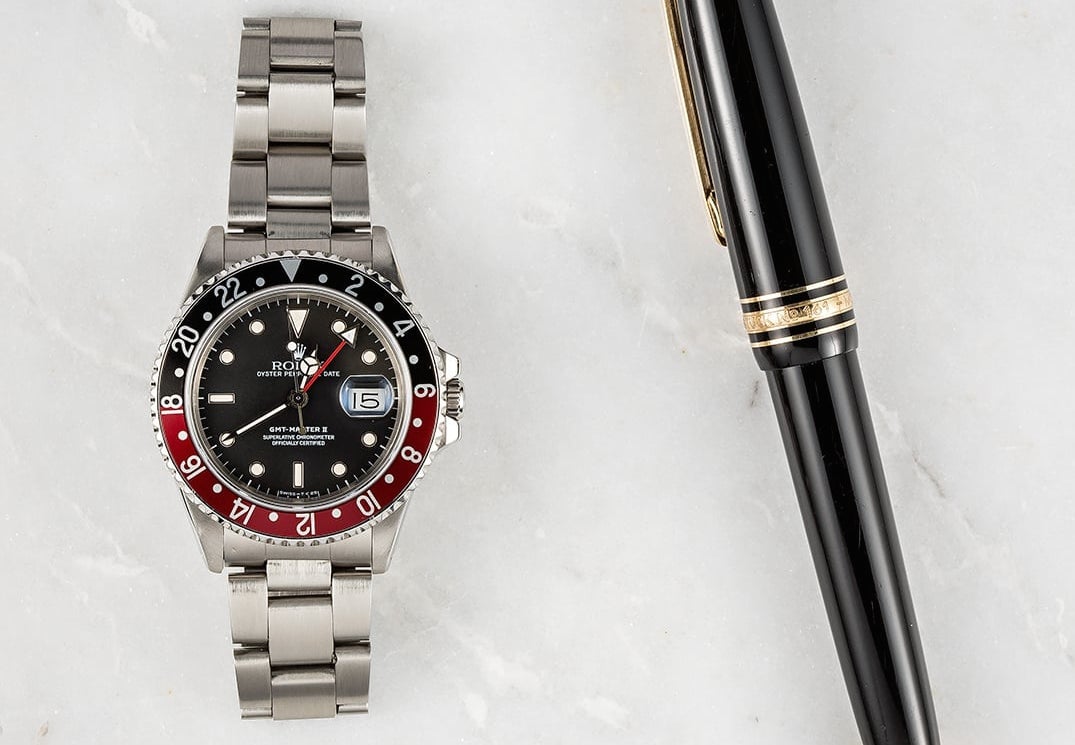
Rolex GMT-Master II ref. 16760 is only 0.5 mm larger.
The reference 16760 GMT-Master II was fitted with a case that was slightly thicker (by about 0.5 mm) than its predecessors. As a result of this minor design variation, the entire watch takes on a somewhat more rounded and curved appearance. Although subtle, this minor design variation has resulted in the reference 16760 earning the nickname the “Fat Lady” among many members of the Rolex-owning community.
Red Line
The reference 1680 was the first Submariner to ever be manufactured with a date complication, and as a result, it holds a special place in the legendary model’s history. While the Submariner was originally designed as a time-only dive watch, the reference 1680 marks the point in the Submariner’s history where Rolex’s iconic dive watch first started to take its contemporary form.
For the first half of the reference 1680’s production run, the Submariner name appeared in red text on the dial surface. However, during the second half of production, Rolex switched to all white text – a practice that has been maintained ever since.
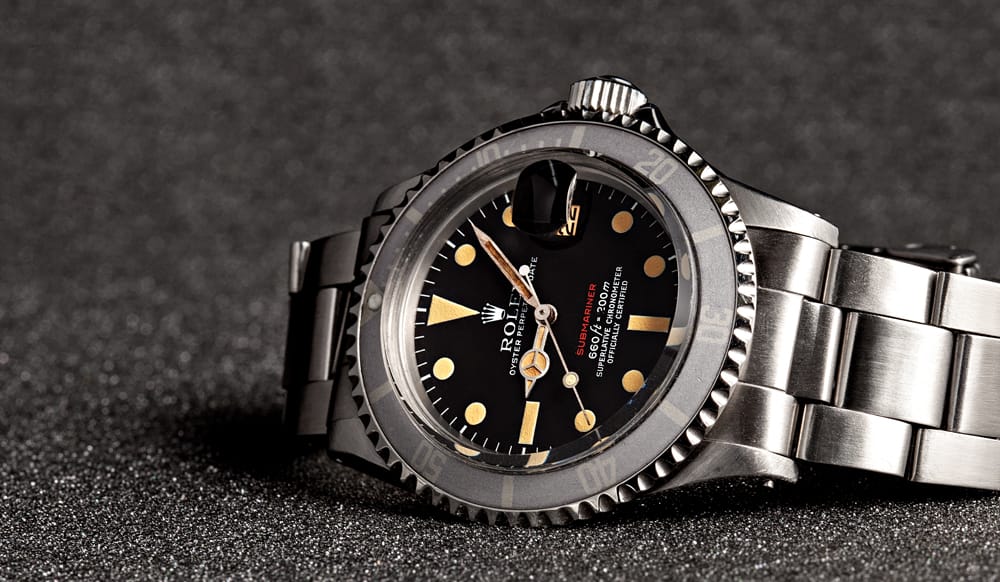
The Rolex Red Submariner 1680 is a watch that is prized for its red line.
To distinguish between the different types of reference 1680 dial variations, early production models with the red writing became known as “Red Line” Submariners among many members of the collecting community. Rolex manufactured Submariners with this style of dial for a number of years; however these “Red Line” dials have become quite rare over time, as it was a practice for Rolex to replace them when watches came in for regularly scheduled servicing.
Double Red Sea-Dweller / DRSD
Much like how early reference 1680 Submariners had the Submariner name printed in red on the dial, some of the very earliest reference 1665 Rolex Sea-Dwellers also featured red lines of text. Just as Rolex replaced many “Red Line” Submariner dials during routine servicing, many Sea-Dwellers had their dials swapped out by Rolex for later-era equivalents that did not contain any red text.
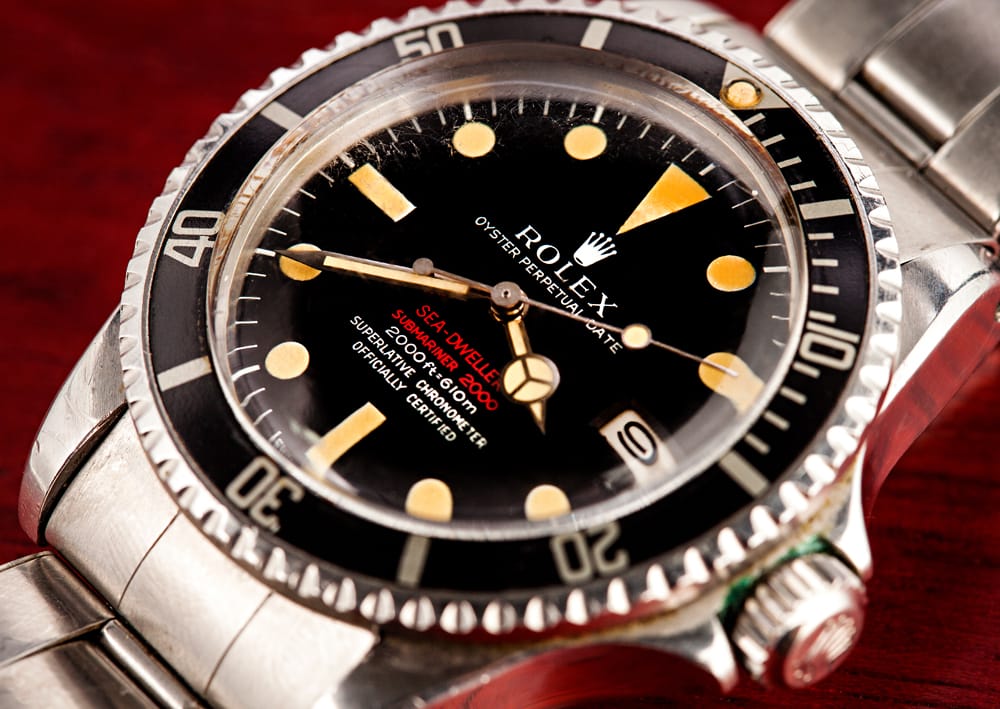
A Double Red Sea-Dweller was confused since it also had “Submariner 2000”.
In the early years of its production, Rolex manufactured the reference 1665 Sea-Dweller with both the Submariner and Sea-Dweller names printed on the dial surfaces in red ink. Due to these two lines of red text, many Rolex collectors refer to these early iterations as “Double Red” Sea-Dwellers (often abbreviated as “DRSD”) to help distinguish them from other reference 1665 Sea-Dwellers with later-era dials.
Great White
In 1977, Rolex phased out the “Double Red” Sea-Dweller dials, and replaced them with dials that used all white text. In addition to the change in color, the “Submariner 2000” line of text was eliminated from the dial entirely, in an effort to draw a further distinction between the Submariner and Sea-Dweller lines of watches.
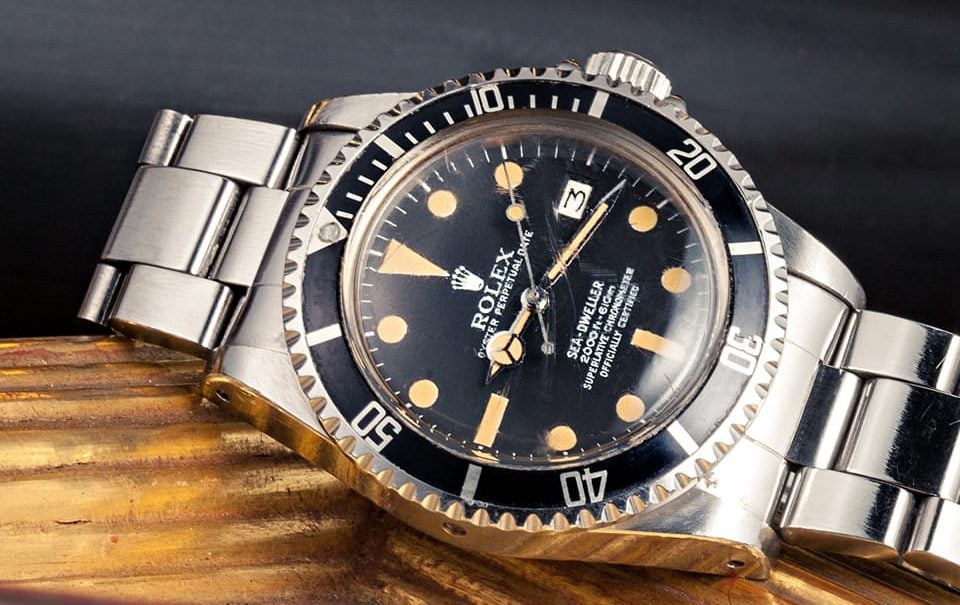
Note the Stainless Steel SeaDweller 1665 has all white text.
Although the dial changed, the reference number for the Sea-Dweller did not; and later reference 1665s that were fitted with dials that had all-white writing have become known as “Great White” Sea-Dwellers among collectors today. Several slight dial variations for the “Great White” exist; however the “Great White” Sea-Dweller is valued because it represents the point in history when the Sea-Dweller first became its own watch line, entirely separate from Rolex’s highly successful Submariner.
Stelline
As one of two watches that Rolex has ever produced with a triple calendar function and moonphase (the other being the reference 8171 Padellone), the reference 6062 is often a target for serious, vintage collectors. Manufactured for only 3 years during the 1950s, the reference 6062 was fitted with dials that had either triangle or star-shaped hour markers.
The reference 6062s that had star-shaped hour markers received the nicknamed “Stelline” through the Italian collector/dealer network, and over the years, the nickname stuck. “Stelline” translates to “little star” in Italian, which is an obvious reference to the watch’s striking, yet whimsical dial.

Rolex Triple Calendar ref. 6062 “Stelline” (Image: Phillips)
Due to their incredibly short production run, impressive feature set, and limited surviving examples, all reference 6062s are considered highly valuable and collectable today. However, the “Stelline” nickname only applies to the reference 6062s that received dials with star-shaped hour markers.
Solo
The “Solo” nickname refers to Rolex chronographs that do not possess any text on the dial other than the “Rolex” name. Generally speaking, the dials of Rolex chronograph watches are fairly text-heavy; however a very small number of vintage chronographs can be found with dials that have only a single word printed on them: Rolex.
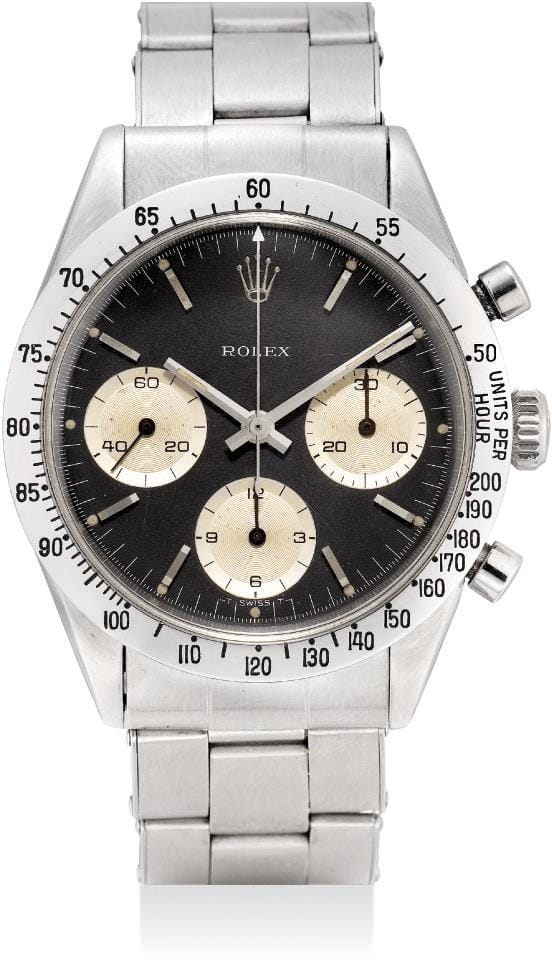
The only words on the watch is “Rolex” thus getting the name Solo.
“Solo” dials can be found on both the reference 6239 and the reference 6240; however there are some that believe that these “Solo” dials should only be fitted to the reference 6239, as the 6240 featured a screw-down crown and chronograph pushers, and thus would have additional text on the dial to mention its Oyster case.
Actual Rolex advertisements for the reference 6239 exist, in which they, show a picture of the watch with a “Solo” dial, so it is safe to assume that these dials are correct for the reference 6238. However, due to the lack of regulation and standardization surrounding certain aspects of Rolex’s production assembly during that time period, it is also highly likely these “Solo” dials were also fitted to certain reference 6240 chronographs at the Rolex factory.
John Player Special
Another vintage Rolex Daytona that gets a nickname is the reference 6241. Due to its resemblance to the iconic black and gold racecars of the Lotus Formula 1 team (sponsored by the John Player & Sons ‘Specials’ cigarette brand), the reference 6241 has earned the nickname the “John Player Special” Daytona. Much like many other nicknames for Rolex watches, the “John Player Special” moniker was something that originated in the strong Italian collector/dealer network, and then simply stuck throughout the years.
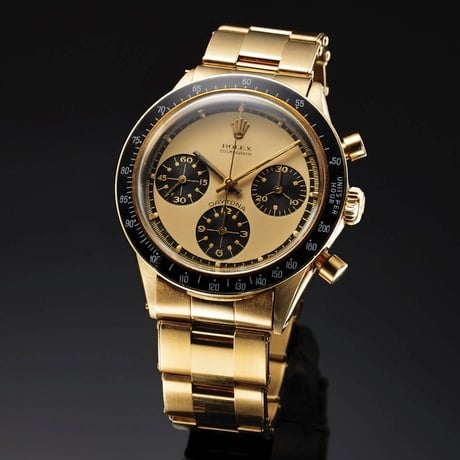
The Rolex Cosmograph Daytona ref. 6241 can be called the John Player Special for its all black and gold make.
Polar
The Rolex Explorer II was originally offered with only the option of a black dial; however with the introduction of the white dial version, people in the Rolex community began referring to white dial variants as “Polar” Explorers.
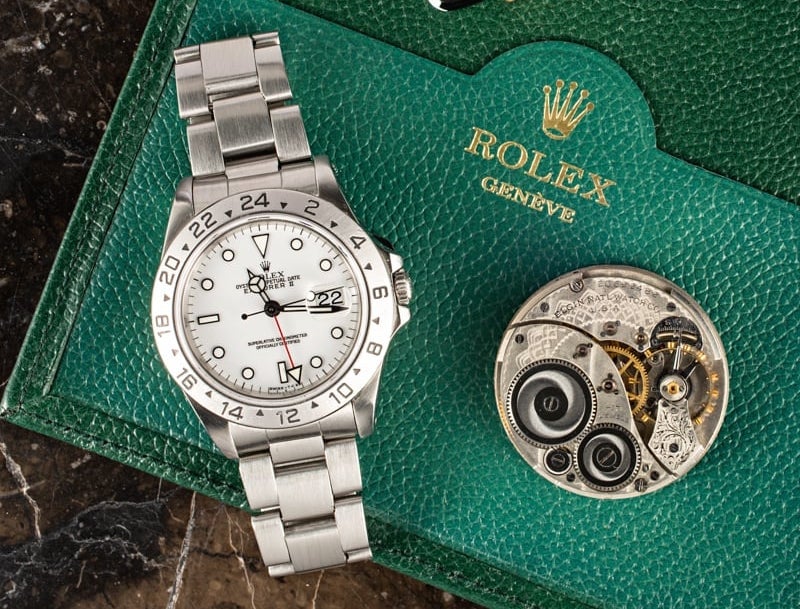
Rolex Explorer II with a white dial is called “Polar”.
On a “Polar” Explorer, the hands and hour markers are finished in black, rather than left as exposed white gold, like on the Explorer II with the black dial. As the Explorer watch lines are designed for explorers and the adventurous, the “Polar” nickname is fitting for the version with the white dial. Other than the dial and hand colors, there is nothing separating about a “Polar” Explorer from a regular Explorer II with a black dial. However, the nickname is a quick and convenient way to make a distinction between the two different watches.
Jean-Claude Killy
Another line of Rolex watches to be nicknamed after a celebrity or professional athlete is the Dato-Compax series of triple calendar chronographs, which have come to be known by the nickname, “Jean-Claude Killy” within Rolex-collectors circles.
Jean-Claude Killy is a former French champion alpine skier who dominated the sport during the late 1960s. As a Rolex brand ambassador, Jean-Claude Killy was at the center of a number of different advertising campaigns, before later becoming a board member for the company.
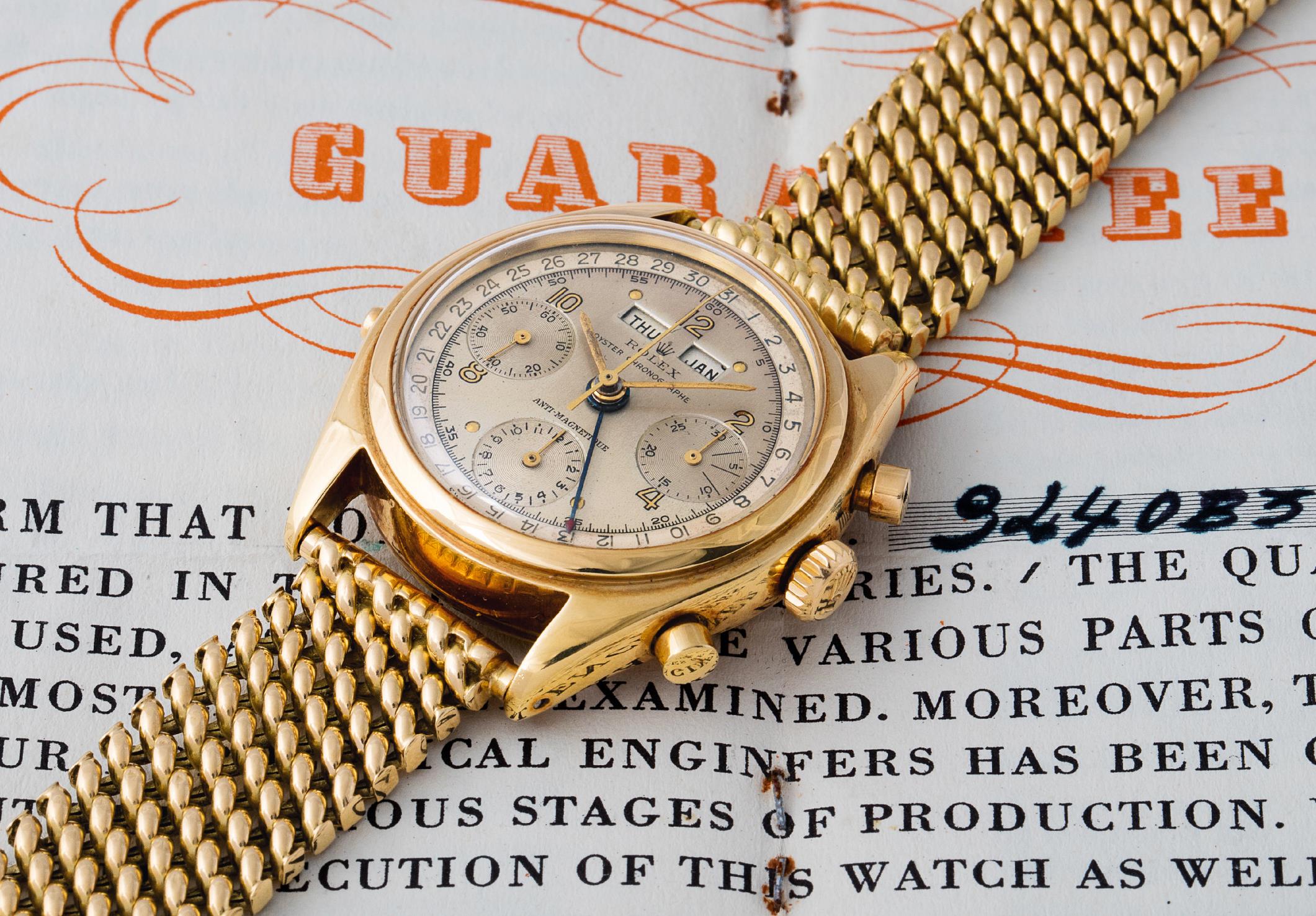
Rolex Dato Compax 6036 is often called the “Jean-Claude Killy” or just “Killy.
The Dato-Compax series of “Jean-Claude Killy” triple calendar chronographs is made up of five different reference numbers (4768, 4767, 5036, 6036, and 6236), and although “Jean-Claude Killy” has never been photographed wearing one of these iconic watches, it can be assumed that at one point in time, he did own one. Regardless, his name is inseparable from the entire Dato-Compax series, and five separate reference numbers have the distinction of being a “Jean-Claude Killy” Rolex.
James Bond
While author Ian Fleming only mentions that his protagonist wears a Rolex, and makes no mention of a specific model, it was ultimately a 6538 Submariner that was on actor, Sean Connery’s wrist during the 1962 film, Dr. No. Since the reference 6538 Submariner was the first watch to be used in a James Bond film, it will forever be known as the original “James Bond” Submariner.
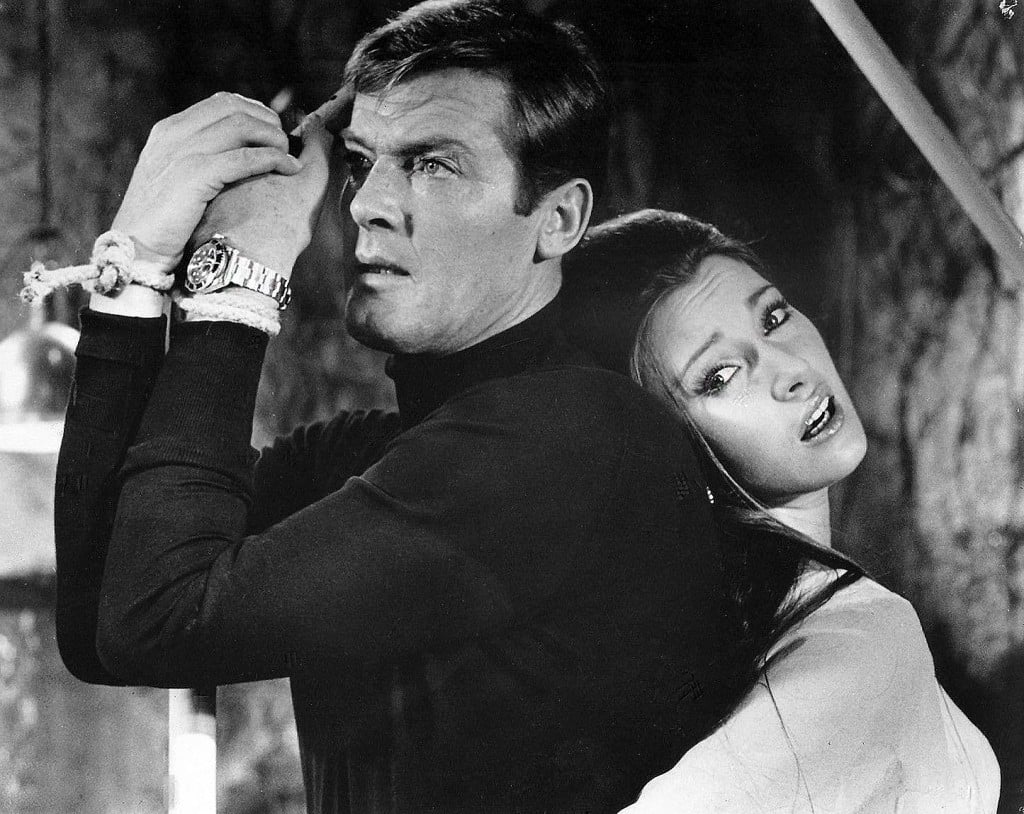
One of the most famous watches is this Rolex Submariner with its oversized crown.
Over the years, Bond has worn a variety of different watches in films, including a number of different Rolex Submariners, several different Omega models, and even a few digital Seiko watches. The large, oversized crown and lack of crown guards of the 6538 Submariner visually set it apart from other, later-era Submariner references. While the “James Bond” nickname often gets incorrectly used to describe other big-crown Submariners, or other vintage references without crown guards, it is actually only the reference 6538 that has the distinction of being called the original “James Bond” Submariner.
Pussy Galore
While the reference 6538 is known as the “James Bond” Submariner, there is another vintage Rolex reference that holds a 007-themed nickname: the “Pussy Galore” GMT-Master.
In the 1964 James Bond film, Goldfinger, actress Honor Blackman wears a reference 6542 GMT-Master while playing the character from the 1959 Ian Fleming novel, “Pussy Galore.” The watch receives plenty of screen-time throughout the film, and its red and blue, bakelite bezel insert make it instantly recognizable as a Rolex GMT.
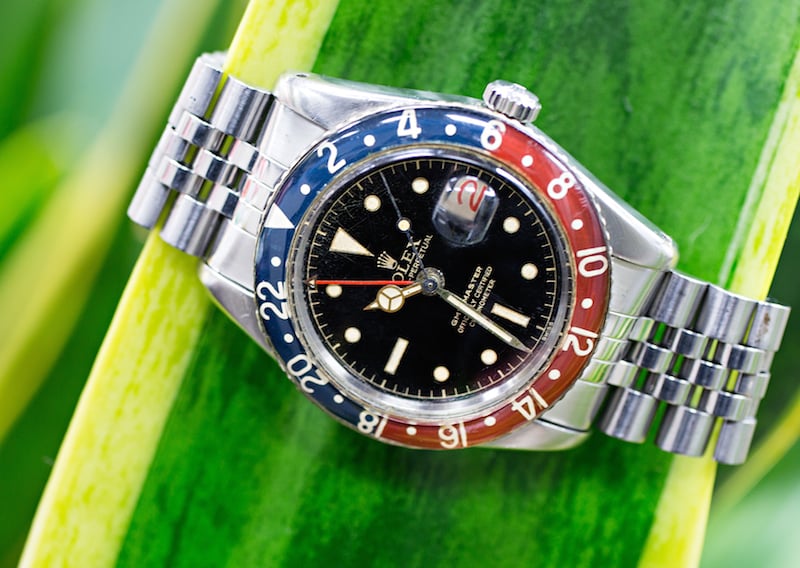
This Rolex GMT-Master 6542 received more air-time than some other people.
The reference 6542 marks the first generation of Rolex’s multi-time zone pilots’ watch, and pre-dates the introduction of crown guards to the GMT-Master line. Today, the reference 6542 “Pussy Galore” GMT-Master is one of the most rare and highly sought-after vintage GMT references – especially if it still has its original bakelite bezel insert.
